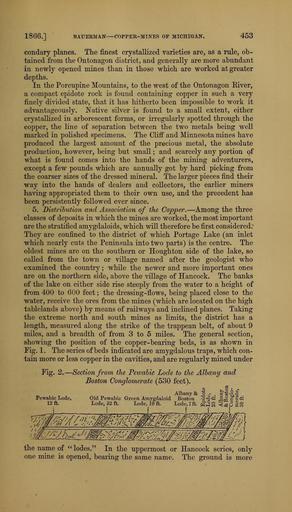MAKE A MEME
View Large Image

| View Original: | The_Quarterly_journal_of_the_Geological_Society_of_London_(13958710603).jpg (1170x2049) | |||
| Download: | Original | Medium | Small | Thumb |
| Courtesy of: | commons.wikimedia.org | More Like This | ||
| Keywords: The Quarterly journal of the Geological Society of London (13958710603).jpg 1866 BAUERMAN COPPER-MINES OF MICHIGAJT 453 <br> condary planes The finest crystallized varieties are as a rule ob- <br> tained from the Ontonagon district and generally are more abundant <br> in newly opened mines than in those which are worked at greater <br> depths <br> In the Porcupine Mountains to the west of the Ontonagon River <br> a compact epidote rock is found containing copper in such a very <br> finely divided state that it has hitherto been impossible to work it <br> advantageously Native silver is found to a small extent either <br> crystallized in arborescent forms or irregularly spotted through the <br> copper the line of separation between the two metals being well <br> marked in polished specimens The Cliff and Minnesota mines have <br> produced the largest amount of the precious metal the absolute <br> production however being but small ; and scarcely any portion of <br> what is found comes into the hands of the mining adventurers <br> except a few pounds which are annually got by hard picking from <br> the coarser sizes of the dressed mineral The larger pieces find their <br> way into the hands of dealers and collectors the earlier miners <br> having appropriated them to their own use and the precedent has <br> been persistently followed ever since <br> 5 Distrihiition and Association of the Copper ” Among the three <br> classes of deposits in which the mines are worked the most important <br> are the stratified amygdaloids which will therefore be first considered <br> They are confined to the district of which Portage Lake an inlet <br> which nearly cuts the Peninsula into two parts is the centre The <br> oldest mines are on the southern or Houghton side of the lake so <br> called from the town or village named after the geologist who <br> examined the country ; while the newer and more important ones <br> are on the northern side above the village of Hancock The banks <br> of the lake on either side rise steeply from the water to a height of <br> from 400 to 600 feet ; the dressing-fiows being placed close to the <br> water receive the ores from the mines which are located on the high <br> tablelands above by means of railways and inclined planes Taking <br> the extreme north and south mines as limits the district has a <br> length measured along the strike of the trappean belt of about 9 <br> miles and a breadth of from 3 to 5 miles The general section <br> showing the position of the copper-bearing beds is as shown in <br> Fig 1 The series of beds indicated are amygdalous traps which con- <br> tain more or less copper in the cavities and are regularly mined under <br> Pig 2 ” Section from the Peiuahic Lode to the Albany and <br> Boston Conglomerate 530 feet <br> Albany I fll4 <br> PewabicLode Old Pewabic Green Amygdaloid Boston - 45 2 c 2« <br> 12 ft Lode 32 ft Lode 19 ft Lode 7 ft p 3 w S Q § ® <br> 'J Ml£ 2y d / <br> the name of lodes In the uppermost or Hancock series only <br> one mine is opened bearing the same name The ground is more 36164900 111477 51125 Page 453 Text v 22 http //www biodiversitylibrary org/page/36164900 1866 Geological Society of London Biodiversity Heritage Library The Quarterly journal of the Geological Society of London v 22 1866 Geology Periodicals Smithsonian Libraries bhl page 36164900 dc identifier http //biodiversitylibrary org/page/36164900 smithsonian libraries Information field Flickr posted date ISOdate 2014-04-21 Check categories 2015 August 26 CC-BY-2 0 BioDivLibrary https //flickr com/photos/61021753 N02/13958710603 2015-08-26 06 53 04 cc-by-2 0 PD-old-70-1923 The Quarterly journal of the Geological Society of London 1866 Photos uploaded from Flickr by Fæ using a script | ||||